An Tir Internal Letter for February, AS XXXX / 2006 CE
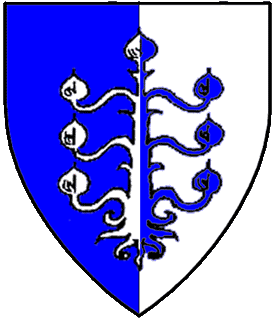 |
Lady Richenda du Jardin, Lions Blood Herald |
- LETTERS FROM KINGDOM HERALDIC STAFF
- AN TIR HERALDIC SYMPOSIUM
- HERALDIC ARTICLES
- LAUREL ACTIONS
- LIONS BLOOD ACTIONS
- NEW SUBMISSIONS
Unto Christopher Black Lion and the esteemed members of the An Tir College of Heralds to whom this missive comes, Richenda du Jardin, Lions Blood Herald, sends greetings and felicitations.
COMMENTARY ON THE ITEMS IN THIS INTERNAL LETTER IS DUE ON THE 10TH OF APRIL.
The February Lions Blood meeting will be held at 1:00 on February 19 at my house. Directions to my house are:
From the West: Take your best route to I-90. Get off on exit 280 (Lincoln Ave/Maple Ave.). Go through two lights and turn right at the next intersection (Jefferson). Go one block and turn left (Fifth). Turn right at the fourth stop sign (Howard). Follow Howard for two blocks - find whatever parking you can in the second block as parking is rather tight. Walk up to 7th and I am in the brick building on the left (524 W 7th.). Buzz apartment #510 and someone will be down to get you.
From the East: Take your best route to I-90. Get off on exit 280 (Lincoln Ave/Maple Ave.). Turn left at the second light (Second). Turn left at the second light (Fourth). Turn right at the next intersection (Jefferson). Go one block and turn left (Fifth). Turn right at the fourth stop sign (Howard). Follow Howard for two blocks - find whatever parking you can in the second block as parking is rather tight. Walk up to 7th and I am in the brick building on the left (524 W 7th.). Buzz apartment #510 and someone will be down to get you.
Limited crash space will be available.
The March Lions Blood meeting will be held at 1:00 on March 19 at Æthan of Eppelhyrste's house (2020 Minor Ave E, Apt. #2 ) in Seattle. Directions:
From North of Seattle, take I-5 South to the Roanoke exit, right after the UW exit. Take a right at the first light (Lynn). Go straight down, through the light (Eastlake), and turn left from Lynn onto Minor Ave E. Go two blocks; halfway down the third block there is a paved area on your left instead of the grass border that usually lines sidewalks. That building is 2020. I am in the ground floor in the middle, just walk on up.
From South of Seattle, take I-5 North to the Lakeview exit, the exit just before the UW exit. Turn left on Lakeview, and follow it to the first light, Lynn. Take a left on Lynn, go straight down, through the light (Eastlake) and follow directions as above.
LETTERS FROM KINGDOM HERALDIC STAFF
From Black Lion
Greetings An Tir!
I have a few bits of business and will then hand the page to Argent Scroll Herald for an important announcement.
I am very happy to announce that as of Twelfth Night the "mini emblazon" is no longer required on any armorial submission in An Tir. The forms are being updated to remove the mini but in the mean time just cross the little picture off and ignore it.
I would like to invite everyone to join us at the An Tir Heraldic Symposium in Wyewood April 8th and 9th.
At Twelfth Night I made a few changes in the Kingdom College's staffing:
- Lady Gwenlian Catharne has been named Queue Forchée Herald. In addition to her existing tasks she is now my contingency deputy.
- Lord Dafydd Caerfyrddin has been named Sable Mountain Herald. He is responsible for Their Majesties courts - heralding them and reporting awards to Dexter Gauntlet Herald.
- Master Finngall McKetterick has been named Goutte de Sang. He is responsible for heraldic rabble-rousing in Summits. His job is to find us some more heralds there.
- Also Lady Juliana de Luna is taking on the additional responsibilities of Jambe de Lion herald. She is the heraldic rabble-rouser in the Inlands area.
- Li Ban has been confirmed as Boar Pursuivant.
The college's roster can be viewed at http://antirheralds.org/college/college.html
In Service,
Lord Christopher Thomas
Black Lion Principal Herald, An Tir
From Lions Blood
I want to start by offering great thanks to Baron David of Moffat, Electrurm; and Dame Zenobia Napthali, Black Stag for the great work they have done on notification letters.
I also want to thank my commenters - Li Ban ingen Echtigeirn, Boar; Juliana de Luna, Jambe de Lion; Ursula Georges, Loyalle; Esclarmonde de Porcairages, Argent Scroll; Alicia le Wilfulle, False Isle Pursuivant; Moreach Nicmhaolain; and Einarr Grimsson, Red Hawk Herald of Calontir!
In the January meeting, several items were sent up with incomplete or no documentation. While I realize many of us get caught on "biffy consults", please take the time to review your submitter's submissions. Submissions that have no documentation require that the kingdom commenters spend more time and energy on those submitters, which pulls time and energy away from submitters who have made a good faith effort in completing their submissions. And that's not fair.
Æstal and Loyalle are available to help both consulting heralds and submitters with getting documentation. They are both good heralds with extensive resources available. Use them.
Since I stepped up as Lions Blood, I've been running articles about commenting. If you have questions, drop me a line. You probably aren't the only one with that question. I will do my best to answer it and get the answer in the next Heralds Page.
In service,
Richenda du Jardin
Lions Blood
richenda@cet.com
AN TIR HERALDIC SYMPOSIUM
Unto the An Tir College of Heralds from Esclarmonde Argent Scroll Comes Greetings,
I invite you all to attend An Tir's premier heraldic event: Kingdom Heraldic Symposium. Symposium offers classes and activities for every level of experience. I hope all the branch heralds, especially those within daytrip range of the site, will encourage your local populace to attend. I have done my best to arrange a schedule in which every class period has something of interest to the non-herald, the new herald, and the veteran herald. The experience of attending Symposium can enrich anyone's understanding of our period and its most colorful of elements.
This year's Symposium features a number of attractions that you won't see every year. We look forward to:
-
Special guests Laurel Queen of Arms and Wreath Queen of Arms
-
A Wreath Roadshow: An Tir armorial submissions ruled on by Wreath on site!
-
A track of activities sponsored by Wyewood's A&S minister in which participants can make items using heraldry
-
Served sit-down feast: pre-registration required (see website)
-
Heraldic Bardic Contest: emphasis on heraldry references rather than vocal ability
You can also look forward to the traditional Symposium offerings:
-
4 tracks of classes on names, armory, field heraldry, and heraldic/scribal arts Consult table
-
On-site lunch for a nominal fee
-
Black Lion meeting
-
Lions Blood roadshow, where Kingdom submissions are ruled on
Directions: This year, the Shire of Wyewood, just south of Seattle, Washington, will host the event. The following directions are "generic" directions that will get you there no matter where you are coming from, but may not be your most direct or convenient route. Please watch the website for directions from the south, the east, etc.
Take I-5 to where it meets I-405 south of Seattle. Take I-405 North (to Bellevue). Take exit 2, Hwy 167 South. Take Hwy 167 to the next exit, which is for 180th/43th Street/ Valley Medical Center. You will actually exit to East Valley Road; take a left onto East Valley and another left onto 43rd/ 180th. You will pass over the highway again. New Horizon School is on the right as you go up a steep hill right after passing over the highway.
Please see our website at http://slumberland.org/symposium/ for complete schedule, fees, feast pre-registration, and directions.
We look forward to seeing you there!
In Service,
Lady Esclarmonde de Porcairages, Argent Scroll Herald and Autocrat
Snail_Or@msn.com
HERALDIC ARTICLES
A Quick and Dirty Guide to Conflict Checking - Part I
The most important thing to remember about conflict checking is that most devices are going to be free from conflict, and those that aren't are mostly easy to change so that they will be. This time, we're going to go over some basic ideas that help you determine where you need to go to conflict check any device. Then next time we'll get to the nitty gritty of conflict checking.
Starting out: What are you looking at?
The first step to conflict checking is figuring out the pieces of the device. Ask yourself the following questions:
What's the primary charge?
The primary charge is the charge or charges in the visual center of the shield. If there is one or more central ordinaries they are usually the primary charge. For example, in "Argent, a bend sable" and "Argent, two bendlets sable" the bend(lets) are the primary charges. If there is no other central charge, a semy is a primary charge. In "Argent, a lion sable", "Argent, three lions sable", and "Argent semy of lions sable" the lions are the primary charges; in "Argent semy of lions sable, a cross azure," the cross is the primary charge. If there are charges only in chief or base, they're the primary charge: so the primary charge of "Azure, in chief a cloud" is the cloud, but the primary charge of "Azure goutty d'eau, in chief a cloud" is the gouttes. Not every device has a primary charge, but most do. A peripheral ordinary (chief, base, bordure, etc.) can never be a primary charge.
Are there secondary charges?
Secondary charges are a single charge or group of charges around the primary charge(s). Therefore, you cannot have a secondary charge without a primary charge to surround. For example, in "Argent, a fess between three lions sable" and "Argent, semy of lions, a fess sable" the lions are the secondary charges, surrounding the primary fess. Similarly, with the case "Argent, a fess and in chief a lion sable", the lion is the secondary charge. In each case if you removed the fess the lions would become primary. There are a couple of special kinds of secondary charges - we'll talk about them more next time.
Is there a peripheral ordinary?
A charge that follows part or all of the edge of the shield, such as a bordure, a chief, an orle of charges, etc. It is not necessary for there to be a primary charge present. For example, in both "Argent, a bordure sable" and "Argent, a lion within a bordure sable" the bordure is the peripheral charge. Peripheral charges act like a kind of secondary charge for conflict checking purposes.
Is there an overall charge?
A charge that overlies a primary charge. The underlying charge is the primary. In period heraldry the overall charge is almost always an ordinary, and usually a bend. For example, in "Argent, a lion sable surmounted by a bend gules" the bend is the overall charge, and the lion the primary.
Are there tertiary charges on any of the charges?
Tertiary charges are charges which lies entirely on another charge. For example, in "Argent, on a bend sable three mullets argent" the mullets are the tertiary charges. You may have different tertiary charges on different charges (though you may not put tertiaries on tertiary charges); in "Gules, a lion Or charged on the shoulder with an annulet gules, a bordure Or crescenty gules," there are two tertiary charge groups: the annulet on the lion and the crescents on the bordure.
What's the field?
This is the background, whether "Sable" or "Per pale vairy gules and ermine and lozengy azure and Or. Some badges are "fieldless"; that's the field.
Is it simple armory?
It's simple armory if it has "no more than two types of charge directly on the field and has no overall charges." You may have learned it differently, because this rule was changed back in 2003. So, whether or not there are tertiary charges doesn't affect whether it's simple armory or not. Remember, type is not determined by tincture, orientation or position. So, a crescent and a decrescent are the same type, as is a bezant and a plate, and a lion rampant guardant and a lion dormant contourny.
So, here's a quiz: for each one, answer the questions above. Answers are at the end of the internal letter:
-
Argent, a tree eradicated sable.
-
Azure, a plate between in fess and increscent and a decrescent.
-
Sable bezanty, three millrinds argent.
-
Or, a tower between three roses, a bordure gules.
-
Per saltire gules and sable, a saltire between in pale two mullets and in fess two lozenges argent.
-
Gules, on a bend argent three gouttes azure and on a chief argent a sunburst gules.
-
Argent, a sword overall a bend gules.
-
Vert, two billets and a lozenge Or.
LAUREL ACTIONS
The following items have been registered by Laurel.
-
Adam Fairamay. Name.
The submitter requested authenticity for 12th-14th C. Withycombe, The Oxford Dictionary of English Christian Names s.n. Adam, lists Adam in 1306. Paired with the cited date of 1327 for Fairamay, this makes for a lovely early 14th C English name. -
Alexsander von Mausheim. Name and device.
Or, in pale a raven maintaining a reed pen inverted perched atop an anvil sable. -
Alîme al-Aydiniyya. Name (see RETURNS for device).
Submitted as Alîme Melek al-Aydiniyya, this name uses a double given name in a Turkish or Arabic name; this practice was ruled unregisterable for Arabic names in September 2001, and we have no evidence for it in Turkish names. The submitter provided two examples of names that might show double given names in Turkish in period: Nefise Melek Sultân Hâtûn and Pa{s,}a Melek Hâtûn. However, this is an unlikely interpretation. Al-Jamal explains:
Of the two [examples]...one is certainly not a case of a double given name: Pa{s,}a Melek Hâtûn is a double title: pasha, an indication of rank, and hatun (Lady). For the other, nefise means "exquisite, beautiful object" - maybe it's a name, and maybe it isn't. Sultan and hatun certainly are titles.
A single ambiguous examples does not a pattern make (sorry); we typically require at least three examples to demonstrate a pattern. Since the submitter explicitly allows dropping the second given name if the full name cannot be registered, we have changed the name to Alîme _al-Aydiniyya in order to register it. -
Anne Johnston. Name and device.
Or, three chevronels and on a chief sable an increscent and a decrescent conjoined Or. -
Ayleth Fairamay. Name.
Nice name! -
Bethel Allen. Device.
Per pale azure ermined Or and Or ermined azure. -
Brocgar Smylie. Name and device.
Per fess Or and azure, a badger statant sable and a round buckle Or.
Smylie is the submitter's legal surname. -
Cerdic Wlfraven. Device.
Vert, a wolf statant to sinister argent and in chief a sun Or, an orle argent.
Please advise the submitter to draw the orle so that there is about twice as much space between the outer edge of the orle and the edge of the shield and to draw the orle two or three times wider. -
Colin Richards. Name.
The submitter requested a name authentic to late 14th C Wales near Carmarthen. However, both name elements were documented as English names. Furthermore, none of the commenters found evidence that the name Colin was used in Welsh. So, while this is a lovely late 14th C English name, it is not authentic for Welsh for that period. -
Dafydd Caerfyrddin. Name and device.
Per pale azure and sable, a wolf statant and on a chief argent three Celtic crosses sable. -
Elisabeth Catesby. Badge.
(Fieldless) A mortar and pestle vert.
Nice badge! -
Elisabeth Trostin. Name.
Submitted as Elisabeth Trost, in German names, patronymic, descriptive and occupational bynames for females should use a feminine or possessive form of the byname. We have changed the name to Elisabeth Trostin to correct the grammar.
The submitter requested a name authentic to 12th-14th C Germany. This is a lovely German name appropriate for that time period. - Eliza Clayton. Name (see RETURNS for device).
-
Guilheumes de Garrigis. Name (see RETURNS for device).
Submitted as Guillaume de Garrigues, the submitter requested authenticity for 12th C Languedoc. While the submitted name appears to be a French form of an Occitan name, it is not the form we would expect to be used in that region. Ramons lo Montalbes, "French/Occitan Names from the XII and XIII Century", lists Guilhelms, Guilelmes, Guilhelmes, and Guilheumes as Occitan forms of the given name. For the locative, Dauzat and Rostaing, Dictionnaire etymologique des noms de lieux en France s.n. Garric, give the forms de Garricis in 1097 and de Garrigis in 1201. We have changed the name to Guilheumes de Garrigis to comply with the submitter's request for authenticity. -
Isibel sviðanda. Name and device.
Per fess rayonny azure and gules, in chief a bear passant argent.
Submitted as Isibel Sviðandi, the byname is a weak adjective and must agree with the gender of the given name. Sviðandi is the masculine form while sviðanda is the feminine. In addition, descriptive bynames in Old Norse are only registered in all lowercase. We have, therefore, changed the name to Isibel sviðanda. -
Margret Elwald. Name.
This submitter requested an authentic Scottish name. This is a lovely 16th C Scots name. -
Martin de Tyr. Name.
Submitted as Martin of Tyre, the submitter requested authenticity for 1177 Tyre. Between 1124 and 1291, Tyre was one of the principal cities of the Crusader States, and we would expect names from several cultures, including French. The submitter cites a Guillaume de Tyr who wrote a history of the crusades in the mid-12th C. While of Tyre is a reasonable English translation of de Tyr, it is not an authentic one -- in 1177, we would expect exactly what we find -- de Tyr, whether the bearer was French or English. Therefore, we have changed the name to Martin de Tyr_ to fulfill his request for authenticity. -
Renard le Fox de Berwyk. Name (see RETURNS for device).
Submitted as Renart the Fox of Berwick, the submitter requested authenticity for 14th C. The given name is documented from 1292 in Paris; however, Reaney and Wilson, A Dictionary of English Surnames gives Henry Renard in 1325. They also have, s.n. Fox, Hugo le Fox in 1297. Bardsley, A Dictionary of English and Welsh Surnames s.n. Berwick, gives de Berwyk, in the time of Edward II (14th C). We have changed the name to Renard le Fox de Berwyk, an authentic 14th C English name.
Several commenters questioned whether a double byname is authentic for the 14th C. In fact, the introduction to Reaney and Wilson has several examples from the 13th and 14th C. In addition, Aryanhwy merch Catmael notes that Great Britain. Assizes (Northumberland). Three early assize rolls for the county of Nortymberland, sæc. XIII. (Durham [Eng.] Published for the Society by Andrews and Co., 1891, has several more examples. Examples are found of both given + locative + descriptive and given + descriptive + locative. Therefore, this name follows a documented pattern for English names. - Rychard Rowntree. Name.
-
Seagirt, Barony of. Badge.
Azure, two pallets argent.
This is clear of Rolf Jarsson, Per pale azure and argent, a pale counterchanged. There are CDs for changes to the field, the number of primary charges, and the tincture of the primary charge(s). When the emblazons are compared, there is sufficient visual difference that RfS X.5 (Visual Test) does not apply. -
Uilliam mac Ailéne mhic Seamuis. Badge (see RETURNS for household name).
Argent, in pale a mullet of eight points voided and a ship within a bordure wavy azure.
A mullet of eight points is simple enough to void, though mullets with more points are not. Please instruct the submitter to draw the bordure with more prominent waves. -
Vivien of Shaftesbury. Name and device.
Gules, a wheat stalk slipped and leaved Or and in chief three escallops argent.
The submitted requested a feminine name authentic to 14th C English, but all the evidence we have for the given name Vivien suggests that it was a masculine name. Many names that we consider masculine today were used by both genders in period. While we have no evidence that Vivien was one of these names, it is not unreasonable to assume that a female might use it. However, because we do not have evidence for this names use by women, we cannot guarantee that this is an authentic 14th C woman's name.
The device is clear of the badge for the Barony of Saint Swithin's Bog, for their Order of Saint Swithin, Gules, a stalk of three cattails slipped and leaved Or. There is a CD for adding the escallops.
A single wheat stalk conflicts with a single cattail. And precedent states:
[(Fieldless) A cattail plant with two cattails argent] Conflict with ... (Fieldless) A tuft of three cattails slipped and leaved argent. There is a CD for fieldlessness. However, both these pieces of armory are effectively cattail plants. The exact number of cattails on a plant may be blazonable but is not worth difference. This also conflicts with ... Vert, three cattails slipped and leaved conjoined at the base argent. That armory also appears to be a single cattail plant, resulting in a similar analysis. [Iron Bog, Shire of, 05/02, R-East]
This means that a plant with multiple cattails conflict with a plant with a different number of (multiple) cattails. However, a single wheat stalk is a period charge, as in the arms of Trigueros, in the Libra da Nobreza, f. xxxvi ║, and no evidence has been presented that a single stalk of wheat is interchangeable with cattails. Therefore, a single stalk of wheat has a CD from a plant with two or more cattails and Vivien's device is clear of the barony's badge. -
Ysoria de Brai. Badge.
(Fieldless) A millrind gules.
Nice badge!
The following items have been returned for further work.
-
Alîme al-Aydiniyya. Device.
Per pale azure and argent, an arrow fesswise, a moon in her plenitude and a flame, one and two, all within a bordure charged with three gouttes counterchanged.
Blazoned on the LoI as Per pale azure and argent, in fess a moon in her plenitude and a flame and in chief an arrow fesswise all within a bordure charged with three gouttes counterchanged, the arrow is large enough to be co-primary, thus this is "slot-machine" heraldry (uses more than three types of charges in the same charge group). This has long been grounds for return per RfS VIII.1.a. -
Eliza Clayton. Device.
Or semy of frogs vert, a wooden wagon wheel "fracted" in dexter chief proper and a bordure azure.
This is returned for lack of blazonability. A wheel fracted would still show the entire wheel. A wheel missing the dexter chief quarter would be missing more of the wheel and would not have the jagged rim, judging by the examples of fractional wheels in Siebmacher. This needs to be drawn either a wheel fracted or a wheel missing the dexter chief quarter. -
Gemma Meen. Device change.
Purpure, on a tower argent a "dog" rampant purpure and in chief a coronet Or.
This is returned for redraw. The tertiary appears to be a lion, not a dog. Charges in a submission must be identifiable, per RfS VIII.3. We would have changed the blazon, except that it is obvious that the submitter prefers to have a dog. If she resubmits with the dog identifiable as such, as in her current device, it should be acceptable. -
Guilheumes de Garrigis. Device.
Argent, an oak tree eradicated proper and on a chief gules three crosses of Toulouse Or.
This device is returned for conflict.
The tree is drawn in a highly stylized manner that many did not recognize as an oak tree. However, such highly stylized trees are found in period armory. Gwenllian ferch Maredudd writes:
I took a look at the emblazon on the An Tir website, and I would say it is within the range of stylized depictions of oak trees found in period Germanic armory. The entertwined branches are a little odd; most such depictions have a more "candelabra" effect (as Parker notes). Nonetheless, I can't see this depiction as unrecognizable or as more than, at most, a step from period practice. ...
As Wreath, Dame Gwenllian ruled "the crequier is simply a stylization of a wild cherry tree (see Woodward, p. 318, along with Plate XXIX fig. 4 and p. 344 fig. 72 for a discussion). While it is a particular stylization, it falls within the expected range of depiction for trees in general. There is no reason to treat it differently from other trees, so it is not significantly different from a generic tree.
Such stylization is unusual for Anglo-Norman armory but not for Germanic armory, in which many types of flora are depicted in very stylized ways. I have, for example, seen linden trees, oak trees, and rose bushes drawn in ways similar to a crequier.
Walter Leonhard's Der Grosse Buch der Wappenkunst, p. 248, fig. 7, shows a stylized oak tree that looks something like a crequier albeit with only 5 branches. Leonhard says it is an "older depiction." The surrounding pages also show many very stylized trees and plants.
Given the information provided by Dame Gwenllian, this depiction of an oak tree is registerable. However, it conflicts with Rosamund du Grasse, Argent, a willow tree blasted and eradicated, on a chief gules two geese close respectant argent. There is not a CD for changes to the tree, leaving a single CD for changes to the tertiary charges on the chief. -
Owain Mawr. Name.
Conflict with Evan Mawr, registered August 1982. Both given names are Welsh forms of the name John, and, in Welsh, are pronounced identically. -
Renard le Fox de Berwyk. Device.
Per bend sable and argent, two fox's heads erased argent and another sable.
This is returned for conflict with Batu Chinua, Per chevron sable and argent, two wolf's heads erased and a rose counterchanged. There is a CD for changes to the field. There is no difference between a wolf's head and a fox's head. Nor is there a CD for changing one of the charges (the rose) to a fox's head. As the charges are not arranged two and one, the precedent allowing a CD for changing the base-most charge does not apply. Nor does the precedent granting a CD for two changes to the charges on one side of a line of division apply - as explained under the heading Group Theory in the November 1995 Cover Letter - as only the type has changed (from an argent rose to an argent fox's head). -
Uilliam mac Ailéne mhic Seamuis. Household name Domus Insulae
Magnae.
While the words Domus Insulae Magnae means "House of the Big Island", no documentation was submitted nor any presented by the commenters to suggest how this name follows patterns of names for organized groups of people. This is a requirement for a household name. Barring documentation for this construction, as well as having the name in Latin rather than in the vernacular, this name cannot be registered.
LIONS BLOOD ACTIONS
These are the decisions of the January 2006 Lions Blood meetings.
These items will be forwarded to Laurel
-
Æthan of Eppelhyrste. — Name and Device - New.
Sable, a nesselblatt and a bordure embattled Or
Loyalle (Ursula) notes that p. xv of Reaney and Wilson lists a number of Old English bynames that are locative. Among these names is Ælfweard æt Dentune in 972AD. Siren notes that this form of the submitter's byname is found in a most Latin document that dates to 749 AD. She adds that according to "The Electronic Introduction to Old English" http://www.wmich.edu/medieval/research/rawl/IOE/index.html both <æt> and <of> use the dative form.
The bordure is a little on the thin side. The College of Heralds recommends that the bordure be drawn nearly twice as thick as the submitted version. The embattlements should be evenly spaced around the bordure. The indentations equally deep around the bordure (about half the depth of the bordure in and equally far out). Finally, there should be about three indentations across the top and 4-5 around the sides. -
An Tir, Kingdom of. — Heraldic title - New. Loyall Pursevant
The College of Heralds was concerned about possible conflicts with the titles Loyante and Loyaute Pursuivant. However, these two titles are on the Siren January 2006 Letter of Intent to Unprotect (Siren proposes that these mundane titles are not important enough to protect). -
Azemar de Lyon. — Device - Resubmission.
Argent, on a cross cotised sable, five apples stemmed and leaved Or
The addition of the cotises provided the second CD to clear the conflict with the Teutonic Order, Argent, a cross sable. -
Brianna Wulfbeald. — Device Return - Appeal.
Per saltire vert and sable
During the time from the initial return to the appeal, another conflict, Barbara Wrona, Per saltire azure and sable, has arisen. Currently, the An Tir College of Heralds has asked the East College of Heralds with help tracking down the new conflict for a letter of permission to conflict. As this is an appeal, it must be forwarded to Laurel. -
Chikakawa no Shunzei. — Name and Device - Resubmission.
Or, in pale three sexfoils purpure seeded Or each within an annulet purpure
Originally submitted as Shunzei no Chikakawa , the name was changed in kingdom to comply with the documented grammar. The use of locative names as given names is unattested in Japan. In addition, Shunzei was documented as a given name, not a byname.
Chikakawa is a constructed byname that is intended to mean "by" or "near the river." Chikagawa (the unvoiced form) is a modern Japanese placename; however, we can contruct it from elements found in Solveig revised. Solveig cites three nanori and one family name using Chika- as a first element and another family name using the Chinese reading of the kanji:- Chikamatsu "near the pine tree" is dated to before 1600
- Chikakatsu "near the arrow root" is dated to 1332.
<Fujiwara no Shunzei> was a poet who lived from 1114-1204 (cf. http://www.temcauley.staff.shef.ac.uk/shunzei.shtml ). He was also known as <Fujiwara no Toshinari>; Franzeska informs me that <Shunzei> is the Chinese pronunciation of the characters in his given name, while <Toshinari> is the Japanese pronunciation. The poet's granddaughter wrote poetry and fiction. She was sometimes identified as <Shunzei kyo no musume> "Shunzei's daughter" (see http://home.infionline.net/~ddisse/shunzei.html ). I was not able to find <Shunzei> used to identify a woman in any other context; it appears to have been solely a masculine name.
The purpure on the device is a bit pale, more like lavender than purpure. Heraldic tinctures should be more saturated, and consequently, in the case of purpure, darker. -
Eisenmarche, Shire of. — Badge - Resubmission.
(Fieldless) on a tower sable two mullets palewise Or
This is clear of Simon MacLeod (registered jointly with Katerine Radford of Dreywick), (Fieldless) A castle sable charged on the dexter tower with a lion's head erased and on the sinister tower with a unicorn's head couped respectant Or. Per RfS X.4.a.iii, Fieldless Difference, there is one CD for fieldlessness. Per RfS X.4.j, Changes to Charges on Charges, there is a second CD for changing the type and arrangement of the tertiaries. -
Gareth Bythewere. — Device - Resubmission.
Sable, a chevron between in chief three fleur-de-lis in fess and in base a sea-python erect winged sinister Or
The submitter's name was registered in the July 2005 LoAR.
The prior submission, Sable a chevron between three fleurs-de-lis and a python erect contourny Or, was returned in March 2005 because the fleurs-de-lis, as drawn, were neither in fess or in chevron, which raised potential conflicts if the fleurs-de-lis were in chevron. These fleurs-de-lis are clearly in fess.
Several commenters expressed concern regarding the charge in base. By definition a python is a winged snake. I am leaving it to Wreath to determine if this is simply a python or a sea python.
Because this device has more than two types of charges on the field, it is can not be cleared under X.2 Substantially Different Charges, which only requires a substantial change to the primary charge. This device can only be cleared through X.4 Significant Armorial Changes.
This device is clear of the following:
Francesca Lucia d'Alberto dei Lorenzi, Sable, a Greek helmet contourny between four fleurs-de-lys in cross Or. There is 1 CD for the change of primary charge. There is a second CD for the change of arrangement of the secondary charges. Because the chevron had enough room on either side to allow the secondaries to be arranged in cross, the change of arrangement is not forced.
Francesca Lucia d'Alberto dei Lorenzi. Sable, a gorgon's head between four fleurs-de-lys in cross Or. There is 1 CD for the change of primary charge. There is a second CD for the change of arrangement of the secondary charges. Because the chevron had enough room on either side to allow the secondaries to be arranged in cross, the change of arrangement is not forced.
-
Hakon Einarsson. — Name and Device - New.
Per chevron sable and azure, two axes and a horse passant argent
In Norse, the use of accent marks over vowels (á, é, í, ó, ú) are optional. However, when both names with letters could take accents, the accent must be used consistently - either accent both names or leave out the accents on both names. This does not apply to the o-ogonek (the o with the comma underneath) because this is a separate letter from "o." The o-ogonek may be found as ÷ because HTML does not contain a code of the proper display of the letter.
This device submission was colored in crayon. In addition to the potential for crayon color transfer to other pages (especially in the heat of the summer), many crayons do not produce a color acceptable as a heraldic tincture. Again, Crayola and Roseart markers have been found to be the best in terms of clean colors and color fastness. -
Harald Warwicker. — Badge - New.
(Fieldless) A drawknife sable.
This depiction of a drawknife is identical to the charge on his device submission. -
Katerina von Altenstein, — Name and Device - New.
Or, a raven and on a chief sable three gem rings Or gemmed argent
The IL initially listed this as Katerine von Altentstein. During commentary, the typo was discovered. Commenters did the research for both forms of the name.
When blazoning rings with gems, they must be specified as gem rings and the tincture of the gem must be blazoned. -
Tangwystl verch Glyn ap Daffydd. — Name - Resubmission.
Tangwystyl verch Morgant Glasvryn's article "A Simple Guide to Constructing 16th Century Welsh Names" (http://www.sca.org/heraldry/laurel/welsh16.html) gives <David> and <Tangwystyl> as standard modern spellings of names which appear as <David> and <Tanglust> in her source. Her article "A Simple Guide to Constructing 13th Century Welsh Names" (http://www.sca.org/heraldry/laurel/welsh13.html) also has <David>, and gives <Tangwistel> as a thirteenth-century spelling of <Tangwystyl>. The usual modern spelling of the Welsh name corresponding to <David> is <Dafydd>, with one 'f' rather than two: see, for example, Academy of Saint Gabriel Report 1740 (http://www.s-gabriel.org/1740).
<Glyn> was documented as a given name by Jeanne Marie for the November 2003 LoAR: "However, Crescent was able to date Glyn as a given name to 1590 in Cornwall. Therefore, we have returned the given name to its submitted form in order to register this name."
These items are being returned for further work
-
Ayleth Fairamay. — Device.
Azure, a mullet of six points and in chief three violets argent
Her name was registered October 2005.
This device is being returned for multiple conflicts:
Somalia, Azure a mullet argent. There is 1 CD for the addition of the secondary charge group, violets. Per precedent from Master Franšois la Flamme:
There is another CD for changing the type of mullet from a mullet of eight points to a mullet of five points. The rules for change of type of mullets follow the rules for change of number of charges. Mullets of n points will get a CD from mullets of m points if RfS X.4.f gives a CD for changing the number of charges from n to m. [Kouac Myklos, 02/02, A-Ansteorra]
As RfS X.4.f does not give a difference between five and six, there is no CD for the change.Barony of Rivenstar, Azure, a riven star argent. There is 1 CD for the addition of the secondary charge group, violets. Per precedent from Master Franšois la Flamme, there is no CD between a star and a star dismembered.
-
Conal MacLaren. — Device, New.
Per chevron sable and argent, a spider inverted argent and a three headed thistle proper
The consensus of the College of Heralds was that this device had two major style problems. First, the per chevron line of division is too shallow. A properly drawn per chevron line would have an angle of less than 90 degrees.
The second problem is that the line of division is too low on the field. The per chevron line of division should divide the field approximately in half. To do this, the line should start at the bottom tick marks on the sides of the shield and should extend to the top tick marks on the sides of the shield. -
Druim Doineann, Shire of. — Badge, New.
Per chevron sable and vert, in base a laurel wreath argent
This badge is being returned for two reasons. The first is the use of a restricted charge on the group's badge. Laurel wreaths may only be used on group armory, according to the "Glossary of Terms As Used By The College of Arms of the Society for Creative Anachronism, Inc." Table 1, Reserved Charges.
Second, this badge conflicts with the following:
Badge of the Order of the Laurel, (Tinctureless) A laurel wreath. There is no CD for the change to the field or to the charge. Unlike fieldlessness which is 1 CD from everything, tincturelessness will conflict with everything. In addition, there is no CD for the change of position as a tinctureless badge has no position.
Crystalmist, Shire of, Per fess urdy argent and azure, in base a laurel wreath argent. There is 1 CD for all the changes to the field, but no CD for the position of the laurel wreath.
The field division has been reblazoned as per chevron sable and vert instead of per chevron throughout sable and vert because the line of division is not throughout. -
Karen Ollesdotter av Augvaldsnes. — Badge - Resubmission.
Or, a seahorse Gules maintaining two whistling arrows vert
This badge is being returned for conflict with Aodhán Doilfín, (Fieldless) A sea-horse gules. for Grudlann Cois Cuain. There is only 1 CD for the addition of the field as per RfS X.4.a.iii. There is no difference for the addition of the arrows as they are maintained charges.
This badge is clear of:
Anna de Chaalis, Or, a seahorse contourny gules between flaunches pean. There is 1 CD for the change of orientation of the seahorse. There is a second CD for the removal of the flaunches. Again the maintained arrows don't count for difference.
Denis de Courcey of the Kells, Or, a sea-horse erect to sinister vert. There is 1 CD for the change of orientation of the seahorse. There is a second CD for the change of tincture of the seahorse.
NEW SUBMISSIONS
Correction to January 2006 Letter
Morgan ap Hugh
The blazon was missing from Morgan ap Hugh's device submission in January. The blazon is: Argent, on a pie inverted gules between two dragonflies purpure a stag statant contourny Or
New Submissions
To be ruled on at the April 2006 Lions Blood Meeting.
| 1. Aedan Mac Gabraine | Blatha An Oir | Name & Device, New |
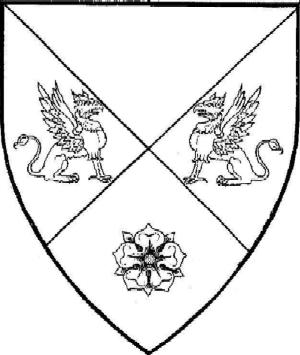 |
Per saltire sable and vert, two gryphons sejant respectant and in base a rose argent. The submitter will not accept any changes to his name, does not care about meaning/sound/ language/culture, does not want his name to be changed to be authentic. He is interested in a male name and will permit a holding name to be formed.
Aedan is found on the St. Gabriel Medieval Names Archive in Gabraine is documented from the same article as Aedan with an entry for Aedan mac Gabran with a date of 606-609. Variant spellings of the name in the article are as follows: Aedhan mac Gabrain, Aedán macc Gabráin, Aedhain mac Gabrain, and Aedhain maic Gabrain. Copies are included with the submission. | |
| 2. Amicia of the Ruins | Madrone | Name, New |
|
The submitter will accept any changes to her name. If her name must be changed, she is interested in a name authentic for language/culture of 14th century England. She is interested in a female name and will allow the creation of a holding name. The submitter indicates that "the first name is well-documented to this time and place" [14th century England - Boar]. She goes on to state that "the byname is locative" and refers to the SCA Shire of the Ruins in Lakeland, Florida. She also states the following: "If you feel you must change the byname to an actual town of the period, please change it to "Amicia de Yorkshire" or "Amicia of Yorkshire." Amicia is documented for Yorkshire in the 14th century." Amicia is documented from Talan Gwynek's "Feminine Given Names in A Dictionary of English Surnames" at http://www.s-gabriel.org/names/talan/reaney/reaney.cgi?Amice where the submitter's preferred spelling is dated to 1189-1346. She dates Amicia to 14th century Yorkshire in another article from the St. Gabriel Medieval Names Archive: Talan Gwynek's "Yorkshire Given Names from 1379" at http://www.s-gabriel.org/names/talan/yorkshire/yorkshire.html[1] in the subsection "Yorkshire Feminine Names from 1379" at http://www.s-gabriel.org/names/talan/yorkshire/yorkf.html. Amicia is listed with a frequency of 6. Locatives as bynames are documented from Talan Gwynek's "A Brief Introduction to Medieval Bynames" at http://www.s-gabriel.org/names/arval/bynames and are defined in the article as bynames that identify you "by the place where you live, work, or were born, or by the land you own." Copies of all documentation is included. [1] URL is incorrect; correct URL is http://www.s-gabriel.org/names/talan/yorkshire/ - Online IL Editor |
||
| 3. An Tir, Kingdom of - Ordre de Cheval et Lion | Order Name, New | |
|
The kingdom name was registered in 1981. The submitter will accept any changes necessary for registration. If changes are required, the submitter is most interested in the meaning which is asserted to be "Order of the Horse and Lion." The submitter is not interested in authenticity for either time period or language/culture. <Ordre de Cheval et Lion> is a constructed French order name meaning "Order of the Horse and Lion." Meradudd Cethin's "Project Ordensnamen" (http://www.sca.org/heraldry/laurel/names/order/) lists a (perhaps legendary?) order of the <Dog and Cock> dated to 500 and attributed to France. Other French orders named after animals include <Lion>, 1080, <Tiercelet>, 1377, <Porcupine>, 1394, <Greyhound>, 1416, and <Dragon>, 12th-14th century. <Ordre>, <Cheval>, and <Lion> are all modern French words. The Oxford English Dictionary (http://222.oed.com[2]) s.v. <order>, n. gives <ordre> as the Old French, Anglo-Norman, and Middle French word for English <order>. OED s.v. <lion>, n. gives <liun> as the Anglo-French word corresponding to French <lion>. OED s.v. <cheval> confirms that <cheval> is a modern French word (borrowed into English in the 17th century); OED s.v. <chevalier> gives <chevaler>, <chivaler> as Anglo-French spellings and <chevalier> as an Old and modern French spelling, so <cheval> is reasonable as a medieval French spelling. The submission is signed by Queen Angharad. [2] URL is incorrect; no correct URL found - Online IL Editor |
||
| 4. Cathal Colach | Grimwith | Name & Device - New |
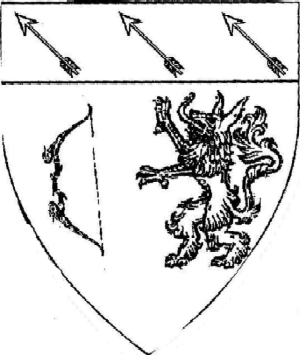 |
Sable, in fess a bow argent and a griffen rampant Or and on a chief gules three arrows inverted bend wise argent The submitter did not mark a box in the "Action Type" box, however, there is no registered name that matches the submitter's.
The submitter will not accept major changes, wishes a male name, and wishes a name authentic for
6th-10th century Scottish. If his name must be changed, he cares most about the meaning, which No documentation was provided for this submission. | |
| 5. Giles Lupino | Terra Pomaria | Name - New |
|
The submitter desires a male name and will allow any changed necessary for registration. If his name must be changed, he cares more about sound. He expresses no interest in authenticity and will allow the formation of a holding name. Giles is found in E. G. Withycombe, The Oxford Dictionary of English Christian Names under the header "Giles." The submitter asserts that the article "Italian Names from Florence, 1427" at http://www.s-gabriel.org/names/ferrante/catasto/ supports the formation of Lupino. He gives a list of examples of surnames formed in the style of Lupino, including Agnolino, Calvano, Calviano, Cambio, Cambrino, Bernardo and Bernardino. Copies of the article are included. |
||
| 6. Jalida bint Yasamin bint al-Susiya | Duncan Chalaidh | Name and Device - Resubmission |
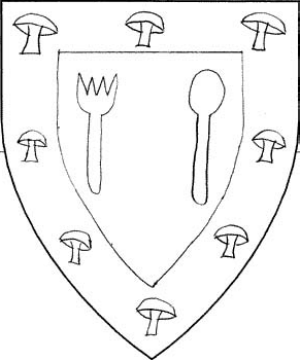 |
Vert, a fork and spoon in fess, on a bordure argent semi of mushrooms azure The submitter will accept any changes, cares most about sound, desires a female name, is not interested in authenticity and will accept a holding name. Originally submitted as Y{a-}sm{i-}n bint al'-Id bint al-Susa in September 2003, no decision was made on either submission. Jalida is found in Manuela Marin's Mujeres en al-Andalus in Juliana de Luna's article in process. Copies were provided. Al Yasamin is found in the same article and book. Juliana states that there are many flower names without the article, such as Banafsj (violet) Bah{a-}r, and Narjis (narcissus). Susa is a place in modern Iran, mentioned in the Bible. It was destroyed in 1218, according to Wikipedia (http://en.wikipedia.org/wiki/Susa). Juliana believes this is the feminine locator byname from Susa. Al-Susi is the byname of a transmitter of hadith (http://www.mb-soft.com/believe/txo/koran.htm). | |
| 7. Laurence of Damascus | Three Mountains | Device - New |
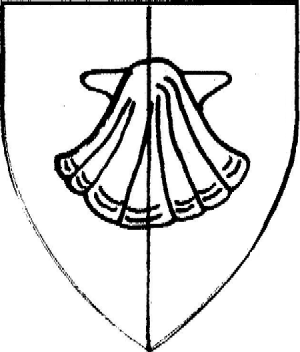 |
Per Pale Argent and Gules, an escallop Counterchanged The submitter's name was registered in August of 2002. | |
| 8. Margaret Fae | Blatha An Oir | Name & Device - New |
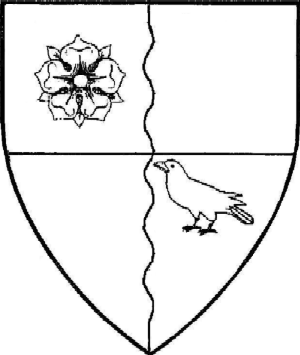 |
Quarterly per pale wavy argent and sable, a rose and a raven sable. The submitter will not accept any changes to her name. She desires a female name and does not express a preference if changes are required, nor does she wish her name to be authentic. She will allow the creation of a holding name. Margaret is found in Withycombe, The Oxford Dictionary of English Christian Names, Third Edition, page 206. Fae is found in "Romany (Gypsy) Names) by Arval Benicoeur (Josh Mittleman) and the Academy of Saint Gabriel (no URL is given) as the surname of George Fae. Copies of the Saint Gabriel article are included. | |
| 9. Mathieu Thibaud Chaudeau de Montblanc | Seagirt | Device - New |
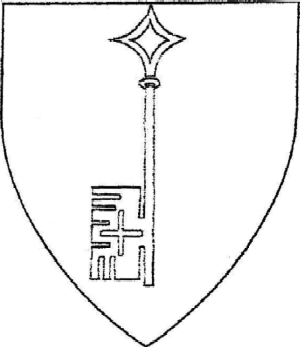 |
Argent, a key palewise wards to dexter sable The submitter's name was registered in October of 1995. | |
| 10. Muirenn inghean Derbail an Dana | Grimwith | Name & Device - New |
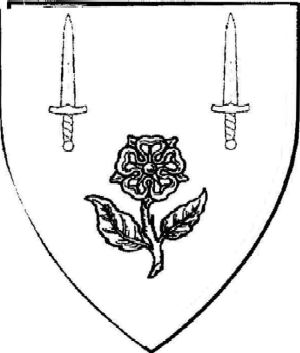 |
Purpure, two swords and a rose slipped and leaved argent The submitter did not choose an option from the "Action Type" box, however, there is no registered name that matches this submission. The submitter will not accept major changes to her name, cares most about sound, desires a female name and wishes her name to be authentic for 6th-10th century Irish. She will allow the creation of a holding name. No documentation was included with this submission. | |
| 11. Rois inghean Muirenn | Grimwith | Name - New |
|
The submitter will not accept major changes and cares most about sound, wishes a female name and wants her name to be authentic for 6th-10th century Irish. She will not allow the formation of a holding name. No documentation was included with this submission. |
||
| 12. Shannon O'Duncan | Vulkanveldt | Name & Device - New |
 |
Purpure, a mangoch bendwise or between a mushroom and a floppy chef's hat argent The submitter will accept any changes necessary for registration, wishes a male name, cares most about sound and wishes a name authentic for Scottish and Irish (no date given). Shannon is found in The Surnames of Scotland: Their Origin, Meaning and History by George F. Black, Ph.D. under the header of Shannan. It is a diminutive of the Irish sean meaning "old, wise". Dated spellings are Aschenane, 1376; Achinyane, 1488; Aschennay, 1513; Aschennan, 1548; Aschennane, 1546, 1581, 1582,; Shennane, 1684; and Shennan, 1751. All of these are surnames. Aside from the header, there is no mention of the spelling desired by the submitter. Duncan is also found in The Surnames of Scotland: Their Origin, Meaning and History by George F. Black, Ph.D. under the header of Duncan. Dated forms include Duncha, c. 1520; Donnchaid, 1467; Dunnchad, 717; Duchad, 965; Donnchadus, c. 1150; Dunecan, c. 1135; Dunecani, c. 1200; Dunecan, 1240-1249; Dunkan, 1367; Duncanson and Dunkanson, 1367; Duncanus, 1402; Jacob Duncan, 1685; and others. The submitter also lists The Surnames of Ireland by Edward MacLysaght, 1367 in his documentation notes, but does not include any details or listings. Copies of Black are included. | |
| 13. Tita the Wanderer | Hartwood | Name & Device - New |
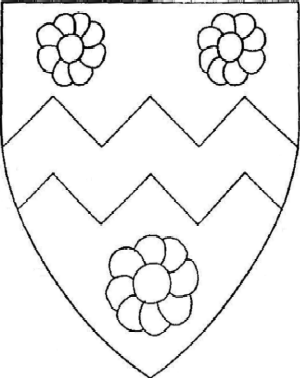 |
Azure, a dance Or between three daisies proper. The submitter will not accept major changes, cares most about sound, wants a female name and is not interested in authenticity. She will allow the formation of a holding name. Tita is found in the article "Feminine Given Names from the Online Catasto of Florence of 1427" by Arval Benicoeur (Josh Mittleman) at http://www.s-gabriel.org/names/arval/catasto/ with a frequency of 9. The Wanderer in conjunction with an Italian given name is discussed in the Letter of Acceptances and Returns for Februrary 2005 [Niccolina the Wanderer, 2/05, A-Atlantia]. Quote follows: Niccolina the Wanderer. Name and device. Per bend sable and purpure, a decrescent and a mullet argent. A check of various Italian-English dictionaries shows wanderer as a standard translation of pellegrino, although pilgrim is the typical translation. Therefore, the byname the Wanderer is registerable as a Lingua Anglica translation of the Italian byname Pellegrino. | |
| 14. Tristram O'Shee | Glymm Mere | Name & Device - New |
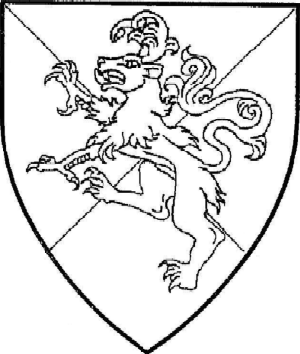 |
Per saltire gules and sable, a calygreyhound rampant argent. The submitter will not accept any changes, desires a male name, and expresses no interest in authenticity. He will allow the creation of a holding name. Tristram is found in E.G. Withycombe, The Oxford Dictionary of English Christian Names, Third Edition, page 283. O'Shee is found in the O'Shee is found in the National Library of Ireland Microfilm P. 8301, Genealogical Office Manuscript 164, Pages 142-150. The article indicates that O'Shee is the Aglicized form of O'Shea and is dated to 1582 by the "...archives of the family and the Records of the College of Arms of England by Robert Cooke Esq. Clarencieux King of Arms and Principal Herald of the East, West and South Parts of the Realm of England at the desire and Particular request of Sir Richard O'Shee of Kilkenny..." "Odanus was the first of the Clann who assumed the Patronymic Name of O'Shea or O'Shee from a Sheadh, one of his Ancestors renowned for Martial Deeds, in obedience to the royal mandate Promulgated by Bryan Boruma, Monarch of Ireland A.D. 1002 to distinguish the different Clans of the Kingdom from each other." | |
| 15. Wilfred of Corwen | Blatha An Oir | Name & Device - New |
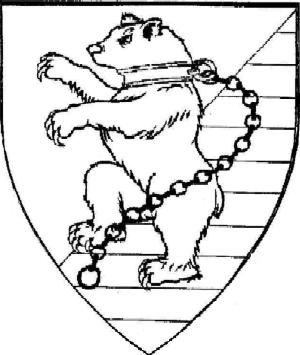 |
Per bend sinister Or and barry argent and vert, a brown bear rampant proper collared gules and chained sable The submitter will not accept any changes, desires a male name, and expresses no interest in authenticity. He will allow the creation of a holding name. Wilfred is documented from E.G. Withycombe, The Oxford Dictionary of English Christian Names, Third Edition, page 293. Corwen is a town in Denbighsire, Wales, lying on the River Dee. It is best known as the base of Owain Glydwr, the fifteenth century Welsh leader. The town grew as a center for cattle drovers. | |
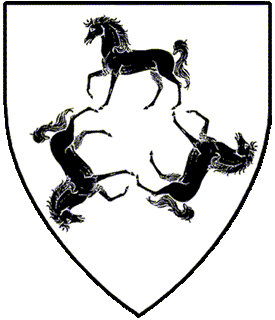 |
Written by Li Ban ingen Echtigeirn, Boar Pursuivant |
The Answers to Conflict-checking Quiz:
- Argent, a tree eradicated sable. Primary: tree; field: argent; simple armory
- Azure, a plate between in fess and increscent and a decrescent. Primary: plate and crescents; field: azure; simple armory (remember the two crescents are the same type)
- Sable bezanty, three millrinds argent. Primary: millrinds; secondary: bezants; field: sable; simple armory
- Or, a tower between three roses, a bordure gules. Primary: tower; secondary: roses; peripheral ordinary: bordure; field: Or; not simple (count the types of charges on the field)
- Per saltire gules and sable, on a saltire between in pale two mullets and in fess two lozenges argent Primary: saltire; secondary: mullets and lozenges; field: per saltire gules and sable; not simple (count the types of charges on the field)
- Gules, on a bend argent three gouttes azure and on a chief argent a sunburst gules. Primary: bend; peripheral ordinary: chief; tertiary: (1) gouttes (2) sunburst; field: gules; simple armory (remember tertiaries don't count)
- Argent, a sword overall a bend gules. Primary: sword; overall: bend; field: argent; not simple (overall charge)
- Vert, two billets and a lozenge Or. Primary: billets and lozenge; field: vert; simple armory